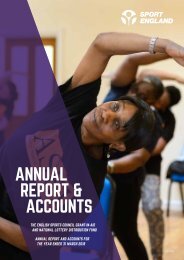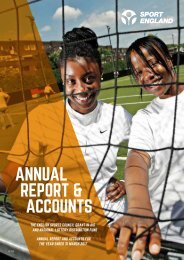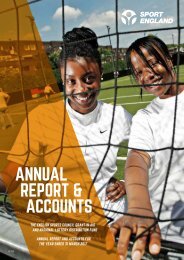sport-england-2016-17-annual-report-and-accounts
You also want an ePaper? Increase the reach of your titles
YUMPU automatically turns print PDFs into web optimized ePapers that Google loves.
MOVING TO SUPPORT<br />
THOSE ALREADY ACTIVE<br />
WE’RE CONTINUING TO INVEST IN OUR CORE<br />
MARKET – THOSE WHO HAVE AN EXISTING<br />
SPORT AND ACTIVITY HABIT<br />
Supporting <strong>sport</strong>’s core market<br />
Long-term analysis shows that a third of the adult<br />
population, or 14.4 million people, already have a<br />
<strong>sport</strong> <strong>and</strong> physical activity habit. Every demographic<br />
is represented in this group, but the core market<br />
customers are weighted towards the male, white,<br />
young, non-disabled <strong>and</strong> better-off.<br />
Despite their active lifestyle, we don’t take core<br />
market customers for granted. Their habit may<br />
not be as vulnerable to small interruptions –<br />
working late or friends not available – but the<br />
big changes in life do affect them.<br />
Whether it’s changing jobs, moving home, starting<br />
a family, retirement – these familiar milestones can<br />
have a dramatic effect on an individual’s activity<br />
pattern <strong>and</strong> often cause it to stop completely.<br />
Those from under-represented groups are more<br />
vulnerable to these changes, which is why<br />
our first new core market fund in <strong>2016</strong>-<strong>17</strong> is<br />
aimed at reaching exactly those customers.<br />
Investment decisions will be made in June 20<strong>17</strong>.<br />
Sporting Future also asked us to make the delivery<br />
of <strong>sport</strong> more efficient. Traditionally, large amounts<br />
of public funding have been spent on providing<br />
<strong>sport</strong> for the already-<strong>sport</strong>y.<br />
As a result, some <strong>sport</strong>s organisations have<br />
become progressively more reliant on public money.<br />
An objective in <strong>2016</strong>-<strong>17</strong> has been to try to reduce<br />
the subsidy, by spending less while still growing<br />
the market. National Governing Bodies (NGBs)<br />
have received awards 33% lower in the 20<strong>17</strong>-21<br />
cycle than in 2013-<strong>17</strong>, <strong>and</strong> will be expected to at<br />
least maintain the numbers of regular players or<br />
participants they influence.<br />
These NGBs are closest to the core market<br />
audience. In fact, they serve around half of the<br />
market through clubs, competitions <strong>and</strong> coaching.<br />
We invested £388.4 million into 48 NGBs between<br />
2013 <strong>and</strong> 20<strong>17</strong>. Each NGB was tasked with<br />
increasing the number of people playing their<br />
particular <strong>sport</strong> <strong>and</strong> helping talented individuals<br />
to fulfil their potential.<br />
Better measures<br />
The Active People Survey (APS) provides the<br />
chief measure for <strong>sport</strong>s large enough to provide<br />
a statistically robust sample size. Smaller <strong>sport</strong>s<br />
often use their own bespoke measures.<br />
This has been the case since 2006, when our<br />
Active People Survey was established. NGBs<br />
have taken responsibility for everyone who<br />
takes part in their particular <strong>sport</strong>, <strong>and</strong> success<br />
was defined as taking part at least once a week.<br />
The final data from APS was published in<br />
December <strong>2016</strong> <strong>and</strong> individual <strong>sport</strong> trends<br />
for the 10 most played <strong>sport</strong>s are shown<br />
on page 21 (opposite). You can download<br />
a full list of all 46 <strong>sport</strong>s by visiting<br />
www.<strong>sport</strong><strong>engl<strong>and</strong></strong>.org/activepeople<br />
Transformative Code<br />
We also need to make sure that organisations<br />
receiving public money are well run <strong>and</strong> reflect<br />
all aspects of diversity in their leadership.<br />
In October <strong>2016</strong>, we launched the m<strong>and</strong>atory<br />
<strong>and</strong> transformative Code for Sports Governance<br />
which dem<strong>and</strong>s more diverse boards, greater<br />
transparency <strong>and</strong> clearer decision making.<br />
We have since worked with 57 <strong>sport</strong>s bodies,<br />
together with UK Sport, to help them prepare<br />
action plans to help them comply with the<br />
Code. Detailed assessments by 31 March 20<strong>17</strong><br />
showed that 70% of requirements are already<br />
being met, showing that the current st<strong>and</strong>ard<br />
of governance in <strong>sport</strong> is broadly good, <strong>and</strong> the<br />
industry has a firm base to build on.<br />
Most of these action plans have now been<br />
agreed, meaning that most organisations will<br />
be compliant by 31 October 20<strong>17</strong>. Some NGBs<br />
have already agreed significant changes <strong>and</strong> our<br />
attention now turns to the assessment of other<br />
organisations we fund who we will also require<br />
to meet the highest levels.








